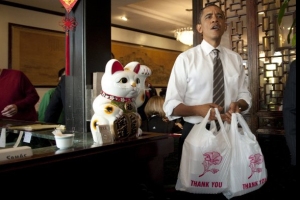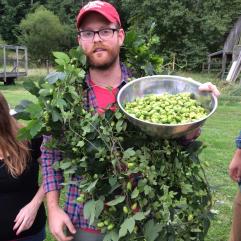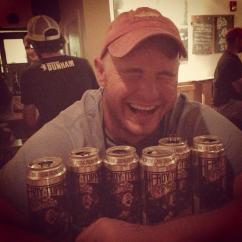Recently I was approached by my good friend and coworker Jon McNabb who had recently began working and writing for the great website indianaontap.com and had been asked to travel to Gnaw Bone, IN to cover the 5th Annual GnawBrew Beer, Art & Music Festival. Jon has always had a great knowledge of not just the skill and process that goes into making great craft beer but also of the history of Indiana’s breweries and what they add to the state’s beer culture, and he wanted an extra set of hands in the field to take notes, chat with the brewers and staff, and (most importantly) taste as much of the available beer as possible. I couldn’t resist. So, the morning of Saturday, July 26th, we loaded into my Ford our sleeping bags, a tent, snacks, water, and enough beer to fuel a festival of our own, and headed east on State Road 46. What follows is a recap of (I think) all the beer we drank, the great food we shared, and insight into each brewery we visited and the great people behind the scenes that are helping put Indiana on the craft beer map.
(UPDATE: You can read Jon’s article for Indiana On Tap here! Give it a read!)
1:00 PM – We stop for lunch at Big Woods Brewing Company in Nashville, IN. This brewery and restaurant has been on the recent uptick, purchasing the whole of a second building to run their brewery, accessory shop, classroom, and an additional pizza shop out of, to go with their standalone restaurant across the alleyway (they call the compound Big Woods Village). Jon and I split an order of BBQ pulled pork nachos, followed by an order of seared ahi-tuna tacos with a sriracha cream sauce (perfect for a humid summer day) for me and some “whammies,” their take on sliders, for Jon. Paired with my lunch were two pints of their Hair Trigger IPA, a hoppy and crispy beer that is fast growing one my favorite IPAs around, and which also served the hair of the dog for me (I had spent the previous night “prepping” for the beer fest, duh).
2:45 PM – We arrive at eXplore Brown County at the Valley Branch Retreat, home of this year’s GnawBrew. After locating the check-in booth, we pick up our (what I liked to call) VIP bands, letting those around us know that the “media” had arrived (no one cared about this more than I did).
3:00 PM – A short trail hike (where Jon drinks the popular orange variant of Sun King’s Fistful of Hops and I a can of Rocket Girl Golden Lager from Asheville [N.C.] Brewing Company) leads us into the heart of the festival, but not before passing the hundreds of tents, campers, and RVs set up by the festival goers who were in it for the long haul. Jon and I both remark that we have never seen a festival quite like this: Woodstock-meets-beerfest-meets-backwoods-hippie-commune. Carharts, camo, dreadlocks, beards, tattoos, couples, college kids – this place has it all. At that point, being our first GnawBrew experience, we are not nearly sure what to expect.
When we finally make it the entrance of the festival, we’re taken aback. At the entrance sits a stage where the day’s musical acts will be performing well into the night. The vendors themselves are set up along a loop around the outside of the grounds, mixing some of the state’s big name breweries with up-and-comers and homebrewers, as well as food trucks, artists, and vendors alike. What better way than to start at the beginning, we decide.
3:02 PM – It is horrifyingly humid, we’ve just realized. See?
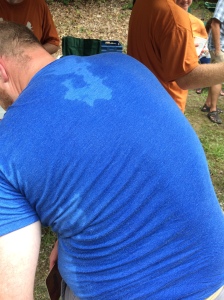
Only a little hot…
3:05 PM – First brewery up: Power House Brewing Co. out of Columbus, IN. We both go for the Ceraline Cream Ale, named for the old Ceraline Mill in Columbus where, as legend has it, the corn flake was first produced. Keeping with tradition, Power House brews this beer with flaked corn, adding to the beer a crisp and sweet finish. We talked with Assistant Brewer Ritch Mettert about their process, providing good craft beer to their area of southeastern Indiana, and even the tale of “Jack the Bum,” the old legend of a man in the 1930s who lived in a shack by a local river who would save local children from drowning, and who also serves as the namesake for their award winning Ale.
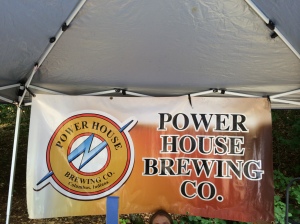
Power House Brewing Co., Columbus, IN
3:15 PM – We move down the line to Three Pints Brewing Co., who hail from Plainfield, IN and are in the midst of opening a second location in Martinsville, IN. I ask for a Meager Giant IPA from the attending sales associate, who is in fact himself a giant (I don’t think the humor was lost on him). As IPAs go, this was a really good IPA – hoppy, a diverse and full flavor, and refreshing in the patented southeastern Indiana humidity.

Three Pints Brewing Co., Plainfield & Martinsville, IN
3:20 PM – We stick around the Three Pints tent and talk to their employees about their expansion to Martinsville, a small town between Bloomington and Indianapolis that hasn’t really been known for its arts or craft beer scene. Being small town Indiana folks themselves, they saw a perfect chance to fill a niche in Martinsville for its citizens, as well as create a reason for people driving past on SR-37 to stop and visit a town often forgotten outside of a place for gas or Starbucks (what a great mission, honestly). Jon and I both try a beer called Yoshi’s Nectar, their take on a California Common, a beer popularized in the 1800s through the use of lager yeasts that, due to the lack of refrigeration, had been adapted to the warmer ale fermentation temperatures, resulting in a smooth, not overly-hoppy blend of ale and lager flavors. We both agree that we could stay and drink Yoshi’s Nectar all day, if not for the other brewers.
3:30 PM – We arrive at the tent of a brewery that Jon is very excited for: Taxman Brewing Company from Bargersville, IN. Easily some of the coolest marketing of not just the festival but any brewery I’ve seen,
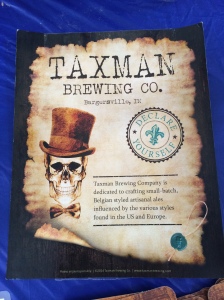
Taxman prides itself on making beers in the vein of the small-batch artisanal brews you’d find around Europe and the Americas. I opt for Deduction, a Belgian Dubbel, which is a stretch for me as I don’t favor the usual bitterness of Belgian beers too much. Deduction, however, was a really pleasant surprise, with a bitterness and sweetness that hits you on the front of your tongue, but doesn’t linger long leaving for a light finish, even at 7.8% ABV.
We linger again around Taxman after we’ve met a gentlemen that used to work the Indiana University Foundation, both Jon’s and my current employer. After name dropping people we’ve both had the chance to work with through the foundation, we part ways, but are left with the lasting impression that the Indiana craft beer scene truly is a homegrown one, made up of people born with a passion for making the best local beer possible and finding avenues to share their work with everyone they can.
3:35 PM – Jon and I move one over to Cutters Brewing Company. After starting a small production brewery in Bloomington, the company moved to Avon, IN in 2012 to expand their production and their reach through the state. Cutters lives its slogan to a tee: “Hard Working Beer.” They don’t set out to be the mad scientists of the craft beer world, instead opting to focus on perfecting a few recipes that leave you with the same satisfied feeling after each sip. I choose my favorite of theirs, the Half Court IPA, a nod to the rich basketball tradition of Indiana. A moderate bodied beer, Half Court is balanced enough to appease both newcomers and IPA veterans alike. Though we don’t linger long, the associates from Cutters make it sound like they’re headed for big things across the state in the near future, and even offered us space next to them to set up our tents and kill their kegs with them post-festival. Definitely a brewery to keep your eye on.
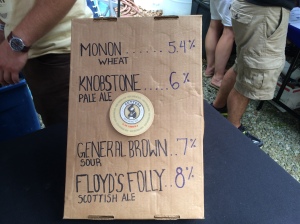
The beer choice from Cutters Brewing Company, Avon, IN
3:37 PM – I’m now feeling the results of what happens when you pour multiple types of beer on top of each other. I am beginning to embrace my backwoods-ness, and may never leave. Is that “Dueling Banjos” I hear?
3:40 PM – We’ve now reached a table we’re both excited for – Bloomington Hop Jockeys. A club devoted to the specific art of homebrewing (and one that Jon and his father, Dan, belong to), this is a true homegrown operation that welcomes both beginners and experts to help in its initiatives. We both opt for the Liz Lemongrass Ale, and are knocked back immediately. Easily the best beer of the day, this Ale has a light and grassy sweetness I’ve never encountered in a beer. When I say I could drink 100 of these beers, I don’t speak in exaggerations. If they were in the production stages, I would always make sure my fridge would have it in stock. Bloomington Hop Jockeys is just another example of the ingenuity of everyday Hoosiers adding to and diversifying an already strong and ever-growing craft beer scene.
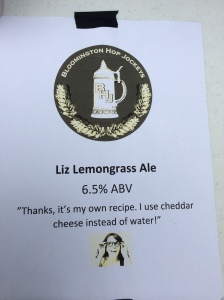
The best beer of the day by Bloomington Hop Jockeys, Bloomington, IN
3:45 PM – After opting for a few more Liz Lemongrass Ales, Jon and I decide to survey the campgrounds found at the back end of the festival. On the other side of a 40 ft. hill, we find what I think to be a game changer – a lake. Already filled with patrons and revelers, I vow, in my beer-and-humidity-induced haze to return for a cool off (I didn’t pack swim trunks, so who knew how that would happen).
3:50 PM – We head back to the homebrew section of the festival and try the Moose Knuckle Brown Ale, an (obviously) Brown Ale that tastes surprisingly refreshing for as hot a day as it was. Again, I’m floored by the clean quality and diversity of flavor in these locally brewed beers.

A member of Team Moose Knuckle pouring a delicious Brown Ale
We’ve now been at GnawBrew for around and hour and patrons are still pouring into the gates. There are more chairs being set up in front of the stage by people coming to enjoy the shows, and you can see more tents and campsites popping up around the grounds. What has resonated with both Jon and I though is that, because of the small amount of tickets sold for the festival overall (around 800), there isn’t an overwhelming amount of people there. This afforded us and every person who wished the opportunity to talk personally one-on-one with the brewers and associates. This is an integral piece of craft brewing anywhere you go: it’s important to drinkers to know what makes their beer and where it comes from, but craft beer drinkers also want to know the hands that made their beer. And brewers, as much as any other artist, want to be known and be integral parts of the communities that they serve. And GnawBrew is working to make that happen.
4:00 PM – Time for another one of my favorite breweries – Fountain Square Brewery, out of Indianapolis, IN, pouring one of my favorites, Hop for Teacher Pale Ale. An American Pale Ale that is more aggressively hopped than you would expect, as they put it, “the slightly bitter finish will keep the hop heads coming back.” As we lingered at their tent for a few minutes, Travis Wilkinson, an associate with Fountain Square Brewing introduced himself to Jon and me. We began a long (well, to be honest, it felt long. Time was a foreign concept at this point) discussion about the culture of craft beer in Indiana, why homegrown events like GnawBrew are important to help advance the breweries that haven’t found their reach yet, what the heavy hitters of Indiana brewing (Sun King Brewing and 3 Floyds Brewing Co. for example) can do to advance Indiana beer on a national scale while shining light on the smaller operations as well, along with the philosophies behind beards and curly-q mustaches. Again, these aren’t conversations you’d be able to have at a Chicago or Indianapolis beerfest.

Marketing for Fountain Square Brewing Co., obviously
4:05 PM – I’m sure more than five minutes passed, but we found the bottom of the keg of Hop for Teacher, which prompted brewer Shawn Byrnes to bring out pitchers of Preacher’s Daughter Amber Ale, brewed with a balance of caramel and biscuit malts. Byrnes sees to it that our cups are never empty. Hoosier hospitality, y’all.
4:10 PM – I felt it important to note here that I got a high five. Not sure why, or from who. But I got one.
4:35 PM – We head over the tent for Zwanzigs, a restaurant and pizzeria in Columbus, IN, and another beer that Jon couldn’t wait to try. Though they didn’t have the beer brewed with ghost peppers that he was looking forward to, they did bring with them a great Porter, as well as a delicious Gose (I underlined it in my notes, so it was obviously pretty great) brewed with sea salt and coriander (surprising I know, but that speaks to the ingenuity of Indiana brewers).
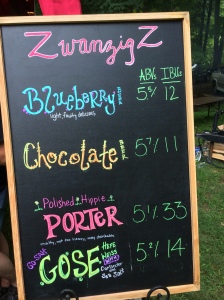
Beer list for Zwanzigz, from Columbus, IN
4:40 PM – We move next door to one of my new favorite breweries – New Albanian Brewing, from New Albany, IN. I again reach out for my comfort zone and go for their Bitter, Beak’s Best (the best individually marketed beer of the day, in my opinion), and am floored. A fruity balance that wasn’t overly sweet, this beer goes down with Liz Lemongrass from BHJ as two of my favorites on the day. The employees from New Albanian make sure to fill us in on some upcoming pop-up events they’ll be throwing, as well as some new chefs coming to their Pizzeria & Public House.
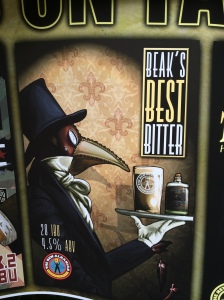
My favorite poster of the day by New Albanian Brewing Co.
4:50 PM – I took time here to note how young and energetic the crowd is here. Most larger festivals you attend, there’s a large contingency of people there just to consume beer and get drunk. And yes, people at GnawBrew were having a great time, but they were taking their time like we were to chat with the brewers, learn about their beers, and make note of other events throughout the state they should attend.
5:25 PM – After another round with the New Albanian vendors, we moved on to Bloomington Brewing Co., one of the best brewers the Midwest has to offer. We shared a few of their signature 10 Speeds, a hoppy wheat beer, and Rooftops, their IPA (named for the Rooftop quarry made famous in the best sports movie ever, Breaking Away). We chatted again with some of the folks that had come over from BHJ before moving down once more.
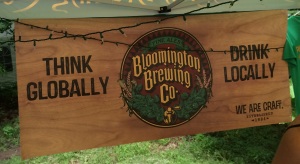
Bloomington Brewing Co., Bloomington, IN
5:55 PM – Next up was Twisted Crew from Seymour, IN. We were both looking forward to this one after sharing a few tweets back in forth in the days leading up with co-owner Joshua Lakins, and their beer did not disappoint. We drank more at this tent and Fountain Square than at any other, as we stuck around to talk with Laskins and his partner Elizabeth Eaken, a craft beer fan and Iron Man triathlete, again about beer, the philosophy of craft beer in Indiana, and comparing Lakins’ beard to mine (his wins – he has a coin to prove it). Jon and I are already arranging a trip to Seymour, IN just to see their facilities, taste more of their beer, and hang out with Lakins and Eaken some more.
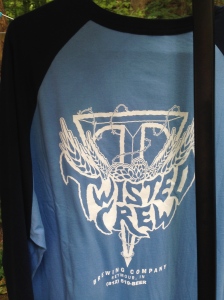
Merch from Twister Crew Brewing Company, Seymour, IN
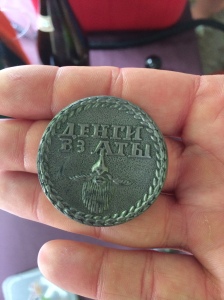
See? I told you Lakins had a coin.
6:20 PM – Following Twisted Crew was Brew Link Brewing and Supply, a brewery and craft beer equipment supplier from Plainfield, IN. I tasted their 21 Guns American IPA, and made VERY BIG NOTES to tell you that it was the best IPA I’d had all day, and they had even decorated their table with some of their hops, giving patrons an opportunity to feel and smell for themselves the ingredients in the beers they were drinking.Their website also features a shop to buy brewing equipment online, along with your grains, hops, extracts, and flavorings, and includes a “brewscussion” forum, for brewers and fans alike to gather and ask questions and bounce ideas off of each other. Quite a resource for anybody involved with or starting out in the brewing process!
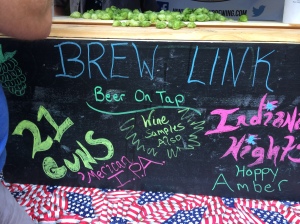
Beer list from Brew Link, including the festival’s best IPA
6:40 PM – We moved on to Tow Yard Brewing from Indianapolis. They brought with them a beer they were currently working on that was a blend between a Radler and a Shandy. Heavy on the citrus and soda flavors, they admitted the recipe was still a work in progress, but Jon and I agreed that what they had so far was delicious and in line with the traditions of Radlers everywhere.
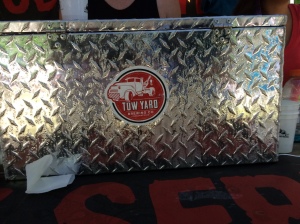
Tow Yard Brewing, Indianapolis, IN
Jon and I at this point felt it important to get some more food in our stomachs. Enter Big Daddy’s Donuts and BBQ Truck. While splitting some grilled tenderloin sandwiches in a spicy BBQ sauce and bag of mini donuts (and salivating over watching a brick-sized piece of lard melt in frying oil), we decided it’d be a great time to make a lap around the festival and take a look at the artists and vendors that had set up shop. We bought some shirts from River City Craft Wear, Jon picked up a new snifter glass, and we watched a man carve a family of bears into the stump of a tree with a chainsaw. Sure, why not?
Small note: this man also carved about a 4.5 foot tall beer bottle of of wood just for GnawBrew. I think I missed my calling in life.
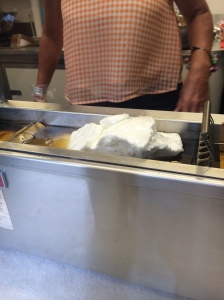
Melting lard – the most beautiful I have ever seen

Hell of a marketing tool
7:05 PM – At this point, we decided to take a seat and listen to some of the performers. Bluegrass, southern rock, and country filled the air as we snacked on beef jerkey, nuts, and the rest of our mini donuts with some water. Clouds had begun to roll in, and text messages from my parents in Bloomington began to turn darker with news of approaching inclement weather. At this point we decided to finish out with the last brewery on the list.
As we stood up, we found ourselves in front of Douglas Talley, the man behind GnawBrew. He let us chew his ear for around 20 minutes as we asked about where GnawBrew came from, who he was trying to serve, and why we as craft beer fans appreciated what he was hosting. What started as a reason to drink good beer with his friends in his backyard and listen to good music, along with play with his own band Gravel Mouth, grew into a festival that all of Indiana could embrace, and that would bring the culture of craft brewing to a small pocket in southern Indiana that has for the last five years embraced it and helped it grow.

Talley (in the black) addressing the GnawBrew crowd
7:35 PM – Fresh off our conversation with Talley, we finished where we began: Big Woods Brewing Company’s tent. We polished off a few more Yellow Dwarf Wheats and Hair Trigger IPAs before calling it an evening and making the hike back to my car (but not before another visit with our new best friends from Twisted Crew
When we arrived at my car, we opened up the back, had a seat, and shared some waters and more snacks while the tunes of The Menzingers played behind us from my car speakers. The winds had grown more cold and the clouds more ominous, so we decided for our own well being that camping was not in our best interest (when I was woken up at 2:30 AM by the sound of thunder rolling over my home, I was pleased with the decision). We packed up the beer, and through sheets of rain drove back west on SR-46 on to Bloomington.
GnawBrew is an event unlike any we’d ever been to. Credit goes to Douglas Talley for assembling such an array of brewers, from homegrown operations to some of the biggest names in the state, teamed with a great display of vendors and artists in a beautiful setting that separates itself from any other festival you’ll attend. Mark your calendar for the final Saturday in July of 2015 for the 6th annual GnawBrew Festival.
Cheers!
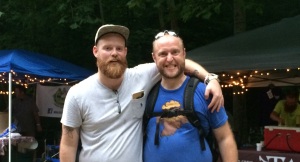
Jon (right) and myself clearly enjoying ourselves

